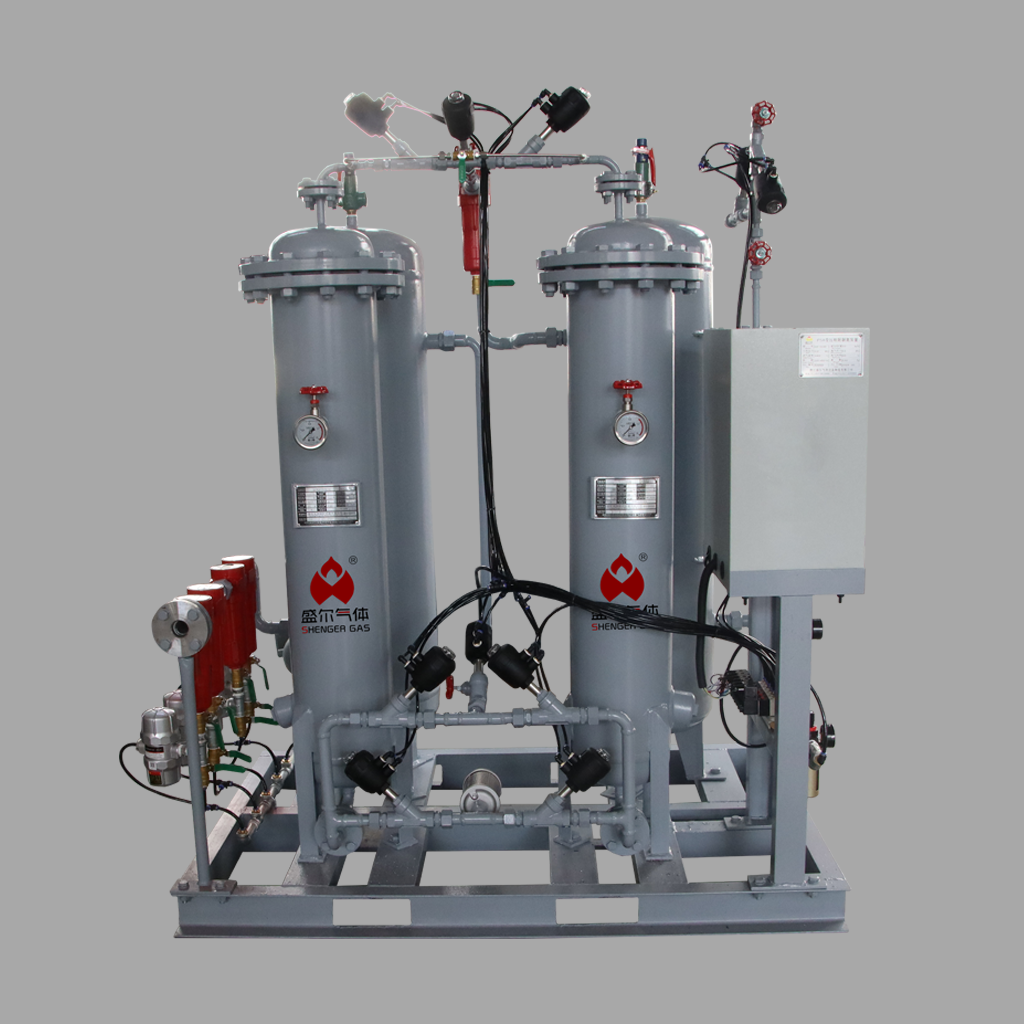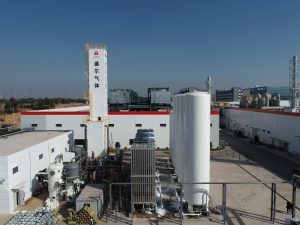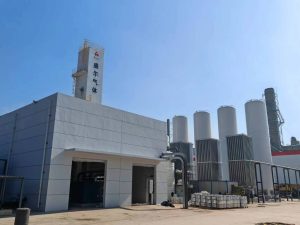1. Introduction: Molecular sieve is the "heart" of nitrogen generator
In industrial applications, the PSA Nitrogen Generator (Pressure Swing Adsorption) has become the mainstream solution for on-site nitrogen generation due to its fast startup, low energy consumption, and compact footprint. Whether it can stably produce high-purity nitrogen primarily depends on the adsorbent — the molecular sieve. The molecular sieve determines nitrogen purity, recovery rate, and energy consumption, while also affecting equipment reliability and lifespan. This article focuses on the **Carbon Molecular Sieve (CMS)** to explain in detail why molecular sieves are essential in nitrogen generators and provides practical guidelines for selection and maintenance.
2. What is molecular sieve: types and functional boundaries
Molecular sieves are porous materials with uniform microporous structures that enable selective adsorption and separation of molecules. In the field of nitrogen generation, there are two common types:
- Carbon Molecular Sieve (CMS): Used in PSA nitrogen generation, it separates oxygen and nitrogen (O₂/N₂) based on kinetic selectivity.
- Zeolite Molecular Sieves (such as 13X, 5A): Commonly used for air purification pretreatment (removing H₂O and CO₂), and also applied in PSA oxygen generation.
The core tower of a nitrogen generator is typically filled with Carbon Molecular Sieve (CMS), while the upstream section is often connected in series with activated alumina/zeolite drying and purification materials to protect the CMS from poisoning by moisture and carbon dioxide.
3. Why must molecular sieve be used in nitrogen generator?
1) Micropore Size and Kinetic Selectivity
- O₂ and N₂ have slightly different kinetic diameters; O₂ is smaller and therefore diffuses faster within the CMS micropores.
- During the short cycles (a few to several tens of seconds) of PSA operation, O₂ is preferentially adsorbed, and the gas enriched at the top of the tower is therefore nitrogen.
- It is this difference in diffusion rate, rather than simple equilibrium capacity, that enables the efficiency and controllability of PSA nitrogen generation.
2) Synergy of adsorption isotherm + rapid cycling
- CMS has high surface affinity and reversible adsorption capacity for O₂;
- Through cyclic switching between pressurized adsorption (capturing O₂) and depressurization desorption (releasing O₂), the CMS can be continuously regenerated with no need for high-temperature regeneration, resulting in lower energy consumption.
- Dual-tower or multi-tower switching ensures continuous nitrogen supply, maintaining stable purity and flow rate.
3) Renewability, stability and economy
- CMS can be regenerated at ambient temperature through alternating pressurization and depressurization;
- With proper front-end purification and operating condition management, its service life can exceed 8–10 years;
- Compared with cryogenic air separation, it offers higher cost-effectiveness for small to medium flow rates and multi-point on-site gas supply.
4. Working steps of molecular sieve in PSA nitrogen production process (simplified)
- Pressurized Adsorption: Compressed and dried air enters the adsorption tower filled with CMS; O₂ is rapidly adsorbed, and nitrogen is discharged from the top of the tower.
- Pressure Equalization: A brief pressure balance occurs between the two towers, recovering part of the pressure and cooling energy to reduce energy consumption.
- Depressurization Desorption: The tower is depressurized and back-purged with a small amount of product nitrogen, allowing the CMS to release O₂ and trapped impurities, completing regeneration.
- Cycle Repetition: The other tower simultaneously enters the adsorption phase, ensuring continuous nitrogen supply.
By optimizing parameters such as cycle time, pressure equalization strategy, and purge volume, a balance can be achieved among purity, nitrogen output, and energy consumption.

5. Comparison with other nitrogen production technologies
- Membrane separation nitrogen production: simple structure, low maintenance, suitable for **medium to low purity (90–98%)** and applications requiring high reliability;
- Cryogenic Air Separation: Suitable for ultra-large flow rates and ultra-high purity applications, as well as industrial scenarios requiring simultaneous oxygen and argon production, but it involves high investment and long construction periods;
- PSA Nitrogen Generation (CMS): Covers a wide purity range of 95–99.999%, featuring fast response and low operating cost, making it the preferred choice for most on-site industrial nitrogen generation.
6. Key parameters of molecular screening
- Kinetic selectivity (αO₂/N₂): The higher the selectivity, the better for separation in a short cycle;
- Specific Surface Area and Micropore Distribution: Influence the O₂ diffusion rate and the number of effective adsorption sites;
- Bulk/Packing Density: Related to the filling amount inside the tower, pressure drop, and production capacity;
- Compressive/Wear Resistance and Anti-Powdering: Affect service life and dust generation risk;
- Moisture Sensitivity: CMS is highly sensitive to water and oil, requiring effective front-end dehumidification and oil removal;
- Particle Size and Bed Resistance: Smaller particle size allows faster mass transfer but results in a higher pressure drop, requiring a balanced design.
7. Operation and maintenance points
- Front-End Purification: Equipped with a refrigerated or adsorption dryer, high-efficiency oil separator, and dust filter to ensure that the dew point and oil content meet required standards.
- Avoid Moisture and Oil Contamination: The inlet air dew point should be significantly lower than the lowest ambient temperature; oil mist can irreversibly block the pore structure.
- Optimize Cycle Parameters: Adsorption/desorption time, pressure equalization strategy, purge volume, and pressure levels should align with the target purity and flow rate.
- Regularly Monitor Pressure Drop and Purity: An increase in pressure drop or fluctuations in purity often indicate bed clogging, powdering, or feed abnormalities.
- Prevent Temperature Rise and Particle Migration: Abnormal temperature increase may result from rapid adsorption heat release or excessive feed; segmented packing and flow limitation should be applied when necessary.
- Replacement and Repacking: Evaluate comprehensively based on purity compliance rate, energy consumption, and pressure drop; during repacking, ensure the integrity of screens and distributors.
8. Common faults and troubleshooting
| Phenomenon | Possible causes | Troubleshooting/handling suggestions |
|---|---|---|
| Nitrogen purity decreases | Failure of front-end water and oil removal, CMS adsorption rate decay, improper cycle time setting | Check dryer and filter; check dew point; optimize adsorption/desorption and pressure equalization time; sample and test CMS activity when necessary |
| Insufficient nitrogen production | Low inlet pressure/flow, bed agglomeration or large pressure drop | Check the air compressor and pipelines; test the pressure drop and flow rate distribution in the tower; reinstall and repair the screen when necessary |
| Increased pressure drop | Powdering blockage, oil and water intrusion, uneven particle size | Take samples to observe dust; check front-end filtration; replace failed filter elements; standardize start and stop to avoid shock |
| Increased operating energy consumption | Cycle parameter deviation, valve group internal leakage | Review control procedures; perform valve body leakage test; calibrate pressure platform and backflush volume |
| Frequent alarms/fluctuations | Sensor drift, valve response hysteresis | Calibrate sensors; check solenoid valves/pneumatic valves; optimize PLC switching cycles |
IX. Technical Paths and Application Recommendations (Comparison Table)
| Indicators/Paths | PSA nitrogen production (CMS molecular sieve) | Membrane separation nitrogen production | Cryogenic air separation |
|---|---|---|---|
| Typical purity | 95–99.999% | 90–98% | ≥99.999% (can produce O₂/Ar simultaneously) |
| Scale/Startup | From small to medium-large scale, featuring fast startup; | Small to medium size, minimal maintenance | Large-scale equipment, long cycle and investment |
| Energy consumption and operation and maintenance | Low energy consumption and cost-effective spare parts; | Lower maintenance, with energy consumption increasing along with purity; | Unit cost advantage under large flow |
| Typical scenarios | Metal heat treatment, electronics, food, lithium batteries, chemical inerting | Shipbuilding, oil and gas, storage and transportation, low-purity inerting | Centralized gas supply for steel, chemical parks, and gas companies |
| Key Dependencies | Molecular Sieve Performance + Front-End Purification | Membrane module quality | Cold box and turbine unit |
10. Why not just any adsorbent?
- The pore size and surface chemistry of CMS are specifically designed for rapid diffusion and reversible adsorption of O₂, delivering excellent performance under short-cycle operation;
- Conventional activated carbon or non-structured porous materials cannot achieve sufficient selectivity and nitrogen production efficiency within second-level cycles;
- Zeolites are suitable for removing impurities with high polarity or larger molecular weight (such as H₂O, CO₂), but are not as efficient as CMS in the kinetic separation of O₂/N₂.
11. Selection and purchasing list (practical points)
- Define the target purity, flow rate, pressure, dew point, and load fluctuation range;
- Require suppliers to provide CMS data on selectivity, particle size distribution, bulk density, compressive strength, and powdering rate;
- Pay attention to the distributor design and packing process inside the tower (layered packing, material retention, and short-circuit prevention);
- Verify the front-end purification configuration (filtration grade, drying method, and online dew point monitoring);
- Evaluate the valve group reliability and control strategy (pressure equalization stage, purge volume, and switching timing);
- Reserve sampling and maintenance ports, and establish operational logs for purity, dew point, and pressure drop.
12. Application Scenario Examples
Table A: Typical PSA Nitrogen Production Targets and Recommended Pretreatment
| Target purity (%) | Target flow rate (Nm³/h) | Recommended inlet air dew point (°C) | Recommended oil content (mg/m³) | Remark |
|---|---|---|---|---|
| 99.5 | 50 | ≤ −40 | ≤ 0.01 | General Electronics/Metal Protection |
| 99.9 | 200 | ≤ −50 | ≤ 0.003 | Lithium battery/precision manufacturing |
| 99.999 | 500 | ≤ −60 | ≤ 0.003 | High-end chemical/semiconductor inerting |
| project | cycle | content |
|---|---|---|
| Pre-filter/fine filter | Check every 1–3 months | Pressure difference, filter element replacement, oil and water discharge |
| dryer | Every 3–6 months | Regeneration/consumables inspection, dew point calibration |
| Valve manifold and seal | Every 6–12 months | Response time, internal leakage test |
| CMS bed | Evaluate every 12–24 months | Purity curve, pressure drop, sampling test |
Table B: Maintenance cycle recommendations
- Metal heat treatment and powder metallurgy: Requires high-purity nitrogen protection and anti-oxidation; PSA+CMS offers fast response and low cost.
- Lithium batteries and electronics: Many processes are sensitive to water and oxygen, requiring low dew points and high purity. Front-end drying and oil control are particularly critical.
- Chemical and petrochemical industries: Frequent inerting and replacement, large load fluctuations; PSA's elastic adjustment capability is more suitable.
- Food Preservation and Nitrogen Packaging: Sensitive to stability and cost; PSA nitrogen generation stands out for its overall economic efficiency.
13. Conclusion
Molecular sieves (especially carbon molecular sieves) are the core of nitrogen generators. Their kinetic selectivity allows O₂ to be preferentially adsorbed within short cycles, ensuring nitrogen enrichment at the top of the tower and stable purity. Their reversible adsorption and ambient-temperature regeneration characteristics make PSA nitrogen generation highly efficient, cost-effective, and reliable for small to medium-large on-site applications. Through proper selection, effective front-end purification, optimized cycle parameters, and standardized maintenance, the service life of molecular sieves can be significantly extended, energy consumption reduced, and product purity of **95–99.999%** consistently achieved.



